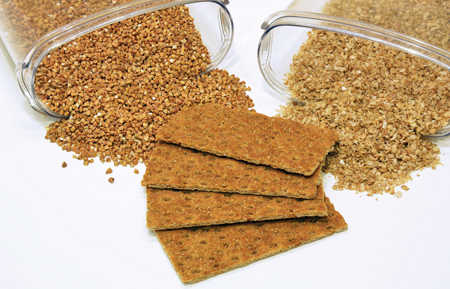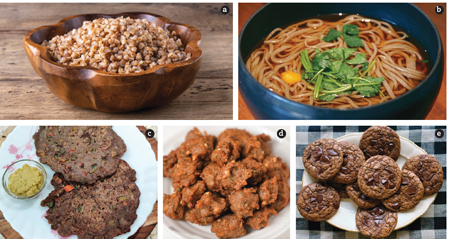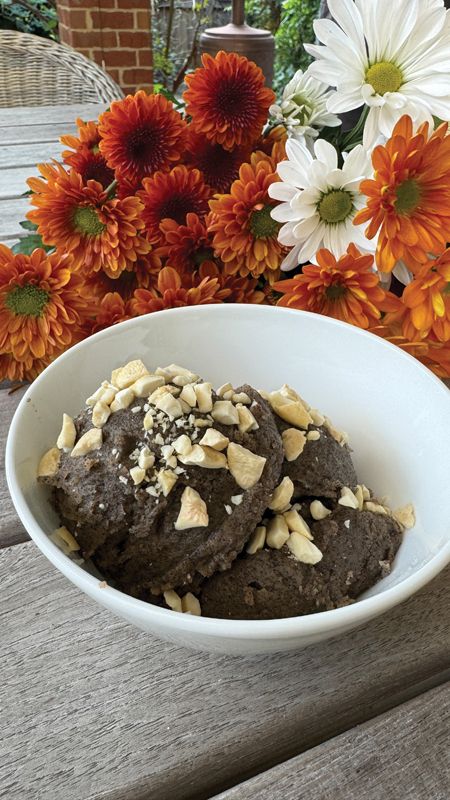Food & Dining: This Navratri Staple Is a Superfood

Incorporate KUTTU (buckwheat) in your globally-inspired cooking.
As we become older and more conscious of what we eat and where we source from, we start paying more attention to well-being, sustainability, and our declining metabolism when making our food choices. We start learning about mindful eating, plant-based diets, and superfoods to keep our energy levels high and stay physically and mentally healthy. Even Western doctors are pointing out the importance of a good diet in reducing anxiety, stress, and depression, and not just increasing longevity and combating diseases.
In South Asian culture, the consumption of ancient grains, immune-boosting spices, healing roots, and barks has always been prevalent. The concepts of Ayurveda, and many everyday ingredients, such as turmeric, have been introduced to the West for their health benefits. The newest in this list is buckwheat, aka kuttu, which is made into flour called kuttu ka atta, vrat ka atta, or papparai. This flour, which has long been a staple food in India and in Ayurvedic medicine for centuries, is now considered a new superfood around the world.
What is buckwheat?
Buckwheat is extracted from the seeds of the Fagopyrum esculentum plant. Its flour has a nutty, slightly bitter flavor similar to wholewheat flour or rye.
Rich in antioxidants, buckwheat is an excellent source of high-quality protein, magnesium, vitamin B6, B3, B1, zinc, and iron. It is packed with fiber and helps boost metabolism, improves digestion, and helps in better weight management. Dieticians advise eating buckwheat to help manage cholesterol, blood sugar levels, and anemia. If you have a gluten intolerance or celiac disease, buckwheat is naturally gluten-free. However, check the labels, as some foods that are prepared with buckwheat are mixed with regular flour. Also, a small fraction of people may have buckwheat allergies.
 A popular fasting food
A popular fasting food
Buckwheat is a satvik (pure) food, synonymous with food eaten during fasting in India, and holds special spiritual significance in Indian culture. It is believed that consuming buckwheat flour during fasts helps purify the body and mind, making it easier to connect with the divine during religious rituals. It is known to maintain physical and spiritual well-being in your body.
[Right] Kuttu (buckwheat), an ancient grain and a staple satvik food in India, is now considered a superfood around the world. (Photo: Andrey Korzun, Wikimedia Commons)
It is especially consumed during religious fasts, particularly those observed during Ekadashi, Maha Shivaratri, and the nine-day Navratri festival in early October. As per Hindu traditions, you should not consume grains and rice during this time, but it is good to have cereals made from seeds as they keep you full longer and don’t deprive you of nutrition during your fast.
Buckwheat around the world
There are plenty of ways to incorporate buckwheat into your cooking. I have been making American-style buckwheat pancakes for years, flavoring the batter with date syrup and fresh mashed bananas for sweetness. When I go to French cafes, I often order savory buckwheat crepes stuffed with smoked salmon or mushrooms. Eastern Europeans frequently prepare grechka—a dish made with toasted buckwheat boiled in milk or water and served with butter. When I traveled around Japan, I often stopped at casual soba restaurants for lunch and learned that eating a bowl of buckwheat noodles before midnight on New Year’s Eve brings you long life and prosperity in the new year. There were dedicated cafes that specialized in serving only chilled thin buckwheat soba noodles, minimally seasoned with soy sauce and seaweed, a lunch staple for the healthy and fit Japanese population. In Italy, the semicircular buckwheat ravioli, called mezzelune, stuffed with ricotta and mushrooms, was one of my favorite dishes.

a. Grechka, an Eastern European dish made with toasted buckwheat boiled in milk or water and served with butter. (Photo: Sams Food).
b. Japanese soba noodles.
c. Kuttu atta chilla, a savory pancake. (Photo: rama@simple cooking_rama/cookpad.com)
d. Healthy pakoras! Made with buckwheat flour instead of besan (chickpeas flour). (Photo: Tarla Dalal)
e. Buckwheat cookies (Photo: from the cookbook, Cannelle Et Vanille Bakes Simple- A New Way to Bake Gluten-Free)
Cooking with kuttu
The versatile buckwheat can be used in an endless number of meal options:
• Breakfast: Start the morning with a buckwheat porridge topped with homemade fruit compote.
• Substitute for flour: Buckwheat can be used for any recipe that calls for flour or quinoa, such as paratha, roti, puri, dosa, wraps, pasta, and sandwiches. Stuff buckwheat flatbreads with spiced mashed potatoes and fry the dough with some ghee to make an aloo paratha.
• Salad Topper: The nutty, toasted buckwheat that is readily available in Indian grocery stores makes for a healthy salad topper.
• Tacos: Make your own buckwheat tacos and stuff them with roasted cauliflower, minced tofu, or grilled chicken, along with lettuce, tomatoes, onions, and cheese.
• Pakoras and other snacks: Use buckwheat flour instead of besan (chickpea flour) to coat homemade sweet potato pakoras and serve them with mint chutney. If you are making tikkis or cutlets, mix in lentils, potatoes, buckwheat flour, and seasonings to make appetizer-size discs that are healthy and taste good.
• Dessert: Sweeten the meal with kuttu ka halwa (see recipe).
• Baking: If you want to continue eating healthy through the holiday season, pick up one of the many recipe books on baking with buckwheat. You can use it to make brownies, cookies, pies, and even granola.
Which one to buy
Buckwheat is usually found in ground form but can also be bought as wholegrain groats, cracked as flakes or cereal, and in processed foods such as pasta. The darker flour is coarser in texture, has higher nutritional value, and is better consumed in salads and granola, whereas the lighter and finer buckwheat flour is ground after the hull is removed, and is better for baking.
Today, you can find readymade buckwheat pasta, soba noodles, and risotto mixes at most grocery and wholesale stores. Always make sure to rinse and toast the hulled buckwheat groats before cooking.
Just like making quinoa or rice, add two parts water to one part buckwheat, bring to a boil, reduce heat, and simmer for 10-12 minutes until tender, then drain off any excess liquid. Store kuttu ka atta in an airtight container placed in a cool, dark place or in the refrigerator to keep fresh.

Recipe:
Kuttu Ka Halwa
Ingredients (Serves 6)
- 1 cup buckwheat flour
- 1/2 cup ghee
- 1 cup sugar
- 3 cups milk or water
- 1 tsp cardamom powder
- 2 tbsp chopped almonds and cashews (optional)
Method
- Heat the ghee in a nonstick wok until fully melted.
- Add buckwheat flour and roast for 5 to 10 minutes until light brown in color but not burned.
- In a separate bowl, make a sugar syrup dissolving water and sugar in the microwave or low heat.
- Add the sugar syrup to the flour mixture, along with cardamom powder.
- Using a wooden spatula, constantly stir the flour on medium heat until it thickens and the water is completely absorbed.
Garnish with chopped almonds and cashews and serve hot.
(Recipe copyright: Sucheta Rawal)
Sucheta Rawal is an award-winning food and travel writer who has traveled to over 100 countries across seven continents, experiencing the world through her palate. She has been named one of the most influential cultural bloggers in the world for her blog Go Eat Give. Find her on social @SuchetaRawal.
Enjoyed reading Khabar magazine? Subscribe to Khabar and get a full digital copy of this Indian-American community magazine.
blog comments powered by Disqus










